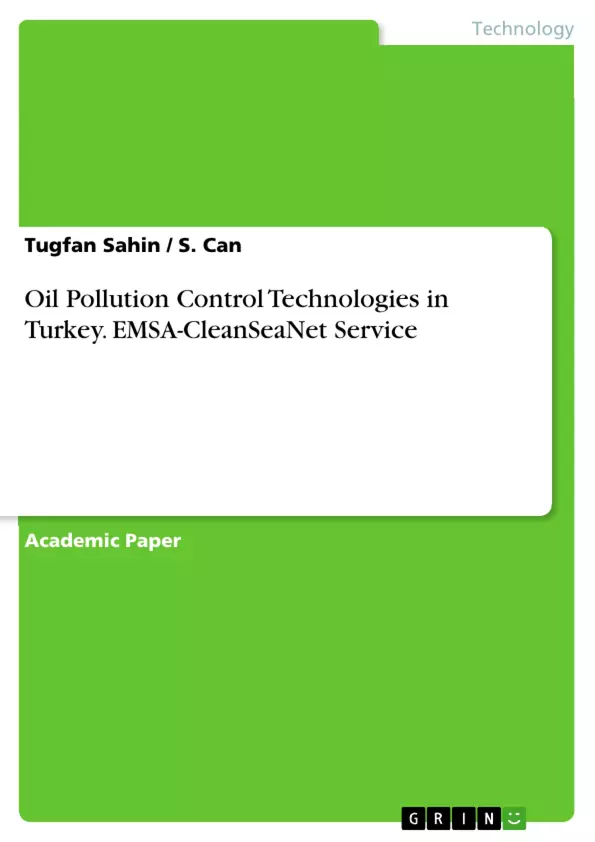The importance of identifying and tracing oil pollution on the sea surface is an important fact in order to protect our environment. CleanSeaNet which is one of the European Maritime Safety Agency’s services is a significant tool and service for the States to increase the environmental safety and prevent marine pollution.
By using the CleanSeaNet service which is supported by satellite technology, the detection and tracing of marine pollution is quite easier and more efficient comparing to previous years. In this study, the CleanSeaNet and its practices in Turkey regarding to identifying and tracing oil pollution have been examined. Furthermore, the practices in Turkey are revealed with a few real-case examples which have been detected by means of pollution control technology; the CleanSeaNet. This paper concludes with the recommendations on future directions on how to identify and trace oil pollution by using new technologies.
The CleanSeaNet is one of the (European Maritime Safety Agency) EMSA’s significant tool which is a European satellite-based oil spill and vessel detection service. It offers assistance to participating States for identifying and tracing oil pollution on the sea surface, monitoring accidental pollution during emergencies and contributing to the identification of polluters. The service is based on the radar images obtained from Synthetic Aperture Radar (SAR) satellites
Inhaltsverzeichnis (Table of Contents)
- 1. INTRODUCTION
- 1.1.Technical specifications of the CleanSeaNet service
- 1.2 Data collection for oil spill detections
- 2. OIL SPILL DETECTION TECHNOLOGIES IN TURKEY
- 3. CONCLUSIONS
Zielsetzung und Themenschwerpunkte (Objectives and Key Themes)
This paper examines the CleanSeaNet service and its use in Turkey for identifying and tracing oil pollution on the sea surface. It highlights the service's significance for environmental safety and pollution prevention, especially in the Black Sea region. The paper also presents real-case examples of oil spill detections by the CleanSeaNet in Turkey, demonstrating its practical application and effectiveness.
- The importance of the CleanSeaNet service for environmental safety and pollution prevention
- The effectiveness of CleanSeaNet for identifying and tracing oil pollution on the sea surface
- Real-case examples of oil spill detections in Turkey using CleanSeaNet technology
- The role of CleanSeaNet in the MONINFO project for reducing ship-based oil pollution in the Black Sea
- Recommendations for future directions in oil pollution detection and tracing using new technologies
Zusammenfassung der Kapitel (Chapter Summaries)
- 1. INTRODUCTION
- 1.1.Technical specifications of the CleanSeaNet service: This section introduces the CleanSeaNet service, a satellite-based oil spill and vessel detection system provided by the European Maritime Safety Agency (EMSA). It describes the technical specifications of the service, including the participating satellites, service providers, and image acquisition capabilities. The section also mentions the 27 participating countries, including Turkey, and emphasizes that the service is free of charge for members.
- 1.2 Data collection for oil spill detections: This section discusses the data collection methods employed by CleanSeaNet for oil spill detection. It highlights the efficiency of the service, citing statistics from 2007 to 2009. The section also includes a graph showing the number of oil spill detections between 2008 and 2014.
- 2. OIL SPILL DETECTION TECHNOLOGIES IN TURKEY: This section delves into the implementation and application of CleanSeaNet technology in Turkey. It highlights the cooperation between Turkey and EMSA, initiated through the MONINFO project, which aimed to reduce ship-based oil pollution in the Black Sea. The section includes a real-case example from the MONINFO project, illustrating the practical use of CleanSeaNet for identifying and addressing oil spills. It then details the jurisdictional framework for oil spill detection and prevention in Turkey, including the roles of different authorities like the Coast Guard, metropolitan municipalities, and the Ministry of Transport, Maritime Affairs and Communications.
Schlüsselwörter (Keywords)
The paper primarily focuses on oil spill detection, marine pollution, and the CleanSeaNet service, a European Maritime Safety Agency (EMSA) initiative. It explores the application of satellite technology for monitoring and preventing marine pollution. The paper also emphasizes the role of the MONINFO project in promoting cooperation between riparian countries in the Black Sea to address ship-based oil pollution. Furthermore, the paper examines the jurisdictional framework and practical implementation of CleanSeaNet in Turkey.
- Quote paper
- Tugfan Sahin (Author), S. Can (Author), 2017, Oil Pollution Control Technologies in Turkey. EMSA-CleanSeaNet Service, Munich, GRIN Verlag, https://www.grin.com/document/412079



